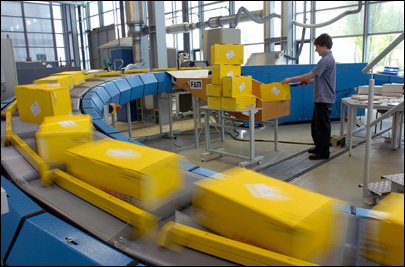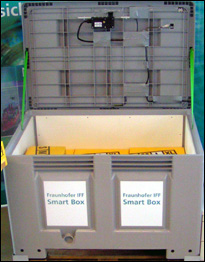The Fraunhofer Institute for Factory Operation and Automation (IFF) has developed an intelligent container that records which RFID-tagged items are put in or taken out of it, and can be tracked throughout a logistics chain with location-sensing technology.
The institute created the Smart Box, now in its final stage of development, in cooperation with global air and ocean freight services provider DHL Danzas Air & Ocean, part of Deutsche Post World Net (DPWN). Work on this project began in February 2005.
The Smart Box combines RFID, GSM, sensors and locating technologies with custom-designed software designed to pull all these elements together. The company is exhibiting it at the DHL Innovation Center, where visitors can test it by adding and removing objects, then track the box’s location as it moves around the showroom. The system makes up an important part of DPWN’s RFID strategy for transporting high-value goods.
“Our Smart Box can tell users what its contents are, and—with GPS and later, Galileo—where it is located,” says Michael Schenk, director of both Fraunhofer IFF and the department of logistics and material-handling systems at Otto von Guericke University in Magdeburg.
RFID antennas are built into the box’s walls and lid, with the remaining electronics—an RFID interrogator that can read 13.56 MHz passive tags conforming to the ISO 15693 standard; a CPU; sensors; a GPS receiver; and a GSM mobile phone unit—installed in its base. The current Smart Box prototype, made of plastic, is about 1.20 meters long by 80 centimeters wide by 80 centimeters deep (47 inches by 31 inches by 31 inches), but the technology can also be used either in containers that are bigger or much smaller.
The reader and antennas can detect when RFID-tagged items are put in or taken out of the container. Sensors measure such factors as temperature, pressure, shock and humidity, while the GPS receiver calculates the box’s location. The GSM mobile phone unit can place an automatic call to a central oversight agency if commanded to do so by the CPU in certain situations, such as when the box is opened unexpectedly or the temperature inside moves beyond set parameters.
IFF has developed the software installed in the box’s CPU and on a PC at the central oversight agency. The software utilizes information collected via GPS, RFID and sensors to create charts for monitoring conditions within the box, or for showing the box’s position on digital maps. All of this information can be shown on a small LCD display attached to the box’s exterior, or on a screen at the central control station.
Now that Smart Box’s developers have finished producing the first working prototypes, DPWN will market the system to customers transporting high-value items and seeking logistics services that are more secure.
Joachim Hermansky, vice president of the European Automotive Industry Sector at DHL Danzas Air & Ocean, says: “Our close collaboration with Fraunhofer IFF brings our clients decisive competitive advantages. Better supervision of their shipments and unrestricted transparency of their shipment data will let them dispatch goods of all types considerably more flexibly, optimize procurement and distribution processes and ultimately reduce logistics costs.”
The Smart Box was developed in IFF’s LogMotionLab, a 1,800-square-meter (6,000-square-foot) facility for testing RFID technology, which opened in Magdeburg three years ago. Schenk says the LogMotionLab is unique because it focuses on industrial applications, including those in the aerospace and automobile industries.
The Smart Box is part of the institute’s efforts to develop tracking systems enabling logistics managers to send and receive information to and from objects, as well as locate and route them around the world.




